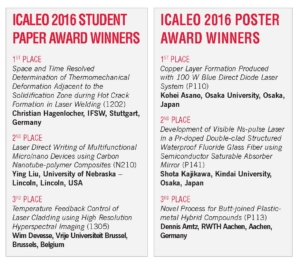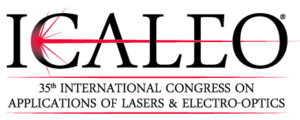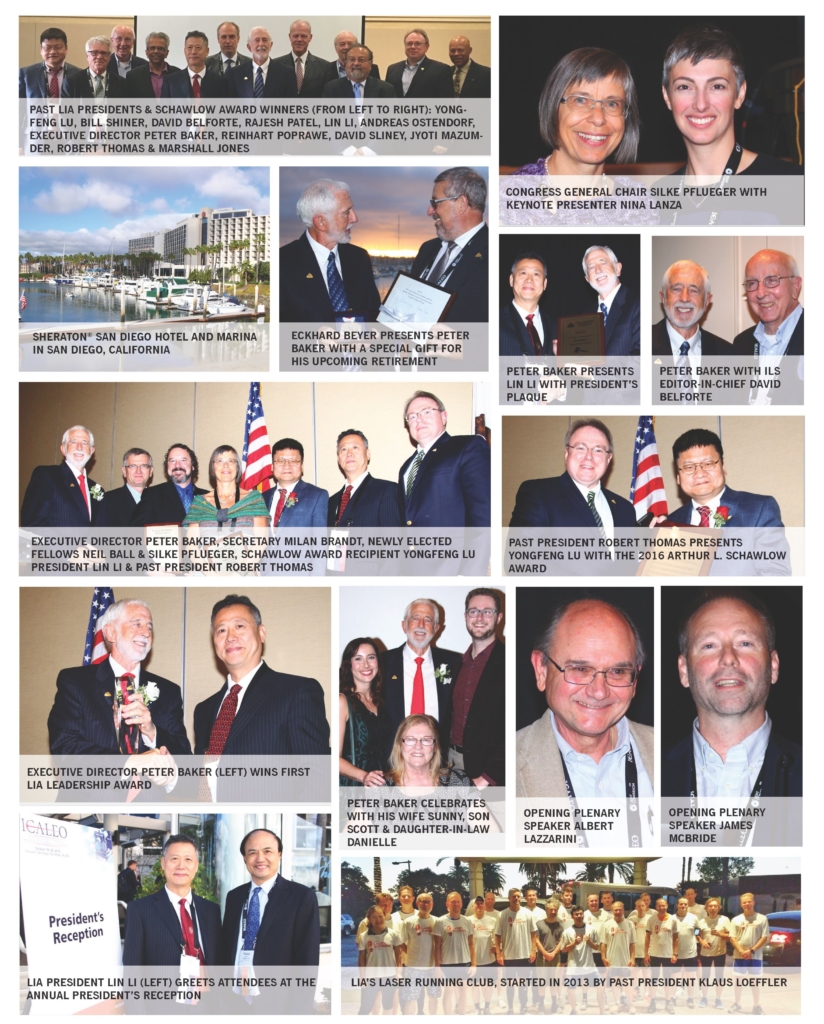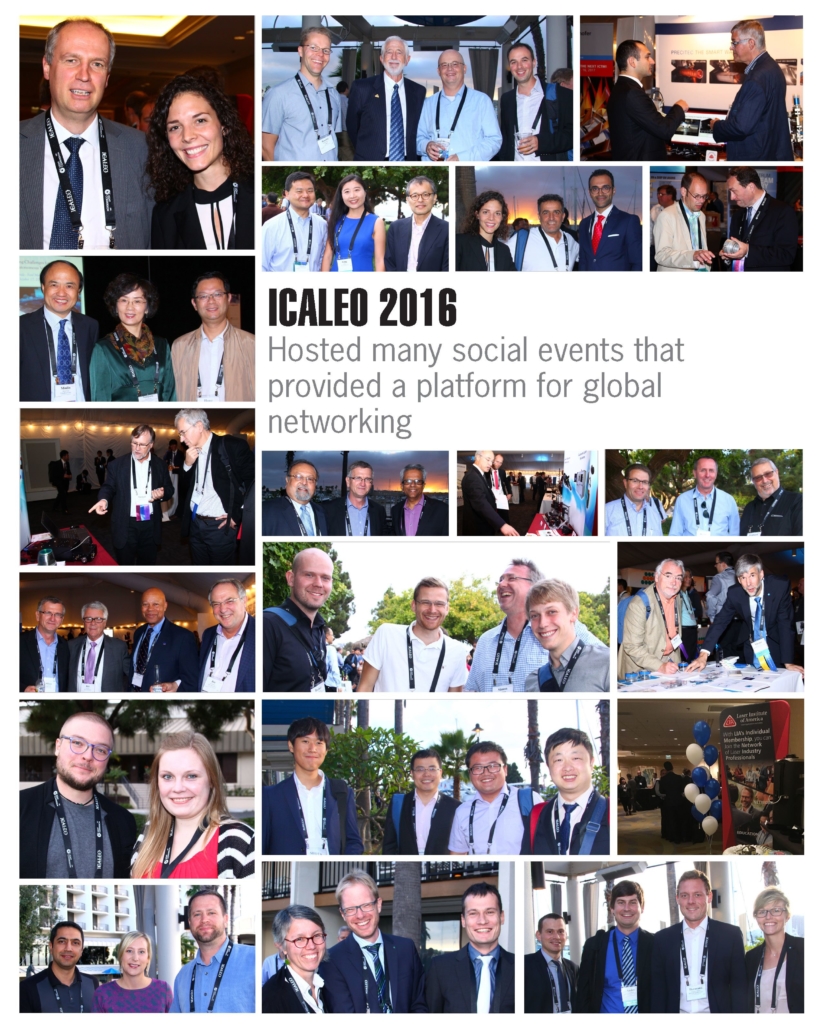Bridging the Gap Between Academia & Industry
By Debbie Sniderman
The 35th International Congress on Applications of Lasers & Electro-Optics (ICALEO®) took place at the Sheraton® San Diego Hotel and Marina this October, 2016. With a highly engaged group of attendees and a great mix of veterans in the field, students and new attendees, ICALEO met its goals of bridging the gap between academia and industry, highlighting new developments in laser technology, and providing a platform for global networking.
“This year’s ICALEO exceeded all expectations once again,” said Jim Naugle, Marketing Director of LIA. “The great location helped increase attendance from 2015. With 415 attendees from 20 different countries, with around 80 percent from academia and 20 percent from industry, you can see why this conference is so unique.”
Congress Technical Highlights
Congress General Chair Silke Pflueger put together unquestionably the best plenary talks ever delivered at an ICALEO conference so far.
Nina Lanza from Los Alamos National Laboratory linked all humanity together in her opening plenary talk about the laser riding around in a vehicle on Mars. Since 2012, the laser in the ChemCam instrument aboard the Mars Science Lab ‘Curiosity’ rover has brought Laser-Induced Breakdown Spectroscopy (LIBS) analysis capabilities and chemical analysis data back to Earth. Along with a Remote Micro Imaging camera, the ChemCam data has provided good signs for habitability of the planet. With its small 350-500 µm spot size, it is able to measure features up to 7 meters away from the rover and ablates material to perform depth sampling by pulsing, revealing “big results” that smectite clays are present underneath the red rocks on the surface of Mars and that dust all over the planet is hydrated. It is also showing the presence of methane, indicating that Mars is not a dead planet; it is active and full of surprises.
Next, Jim McBride from Ford Motor Company talked about the challenges of sensing on fully autonomous vehicles. Ford is developing a fleet of vehicles where a driver has no responsibility of driving, with the goal of having commercially available fully autonomous vehicles in 2021 and cost affordable vehicles in 2026. He explained the three types of sensors used on autonomous vehicles: Radar, cameras and Light Detection and Ranging (LiDAR) scanners. He showed videos of the Ford Fusion Hybrid research vehicle driving completely autonomously on a recent successful 125 mile highway test through the Arizona/California desert using only the LiDAR scanners to image surroundings in a 360 degree view around the car at all times.
McBride showed how 95-99 percent of autonomous driving can be done with input from LiDAR scanners alone. Reading what he calls the pavement’s unique fingerprint: manhole covers, lane markings, tar strips, cracks and all details in a road, localizing the vehicle, the road, and obstacles, centering it within a few cm on the road, tracking obstacles and avoiding collisions is simple for LiDAR. Its data is overlaid on top of high definition 3D maps with road data that has the rules of the road, crosswalks, road signs and other important features, to make sure the road is traversable, using prior knowledge to identify what’s coming ahead and difficult topologies. It has its own light source and isn’t susceptible to shadows and the sun, unlike monocular cameras. And it is much better at tracking other vehicles than with Radar alone, which is noisy. Redundancy helps filter out echoes from challenges such as snow or heavy rain that may obscure the ground plane. With real-time planning without GPS, the laser scanners calculate where to go. But, there are some areas where it doesn’t suffice.
Sensor fusion helps in challenging situations: high closing velocities on two-lane highways when it’s hard to see objects coming, adverse weather and lighting, snow obscuring optics preventing the laser from making it to the ground plane, road debris, and human-negotiated arrangements like four-way stops and merge ramps. In merge scenarios with line of sight issues, sensing has to look in 360 degrees. When turning left or accelerating on a highway on ramp, thousands of possible trajectories are calculated, looking back in time for decision making. But, when fusing LiDAR scanners with other sensors, each still sees only part of the picture.
Albert Lazzarini, Deputy Director of LIGO Laboratory at California Institute of Technology presented the exciting new results about black holes made from the first gravitational waves detected by LIGO. The system involves an extremely stable laser injected into a complex cavity of a Fabry-Perot interferometer with ultra-pure super-polished suspended mirrors coated with forty quarter-wave layers to have reflectivity better than five 9’s. Servo-controlled ground isolations systems stabilize, attenuate and filter out ground motion with input from seismometers, so the laser light that makes about 140 bounces per second is sensitive enough to be considered a transducer for gravitational waves at the output of the interferometer.
All LIGO science data is publicly available on the center’s open website, and since it came online, a total of three events have been observed that are bringing new information – that black holes in binary systems exist. Two identical signals were seen simultaneously by systems in two locations in eastern Washington State and near Baton Rouge in Louisiana. After correcting for differences in orientation and background noise and removing the few-second offset between the locations, it was determined that the gravitational wave signal seen here on Earth corresponded to events that occurred 1.4 billion years ago between two black holes of 29 and 36 solar masses respectively. Signals show how they behave when they interact and provide an estimate of where the event was located in the universe.
Laser Materials Processing (LMP) Conference Technical Highlights
The LMP Conference, chaired by Christoph Leyens from Fraunhofer IWS, brought together laser, manufacturing and materials science disciplines and presented talks on laser drilling, cladding, cutting, welding, additive manufacturing/3D printing and materials for lightweight construction.
A highlight of the lightweight construction talks was about carbon fiber reinforced plastics (CFRP), which are used in many industrial sectors. Sven Bluemel from Laser Zentrum in Germany presented information that will help optimize laser cutting processes in his talk Time Resolved Analysis of Nanosecond Pulsed Laser Processing of CFRP (LMP8-803). Bluemel synchronized a CMOS camera and strobe light with a fiber guided nanosecond pulsed laser to analyze the plasma plume during laser cutting of 3D CFRP parts with different processing parameters. Analysis of pictures of the cutting process and resulting plume showed how the plume varied with pulse energies and changed during processing so ablation thresholds and process boundaries could be set.
Ti6AL4V is the major industrial alloy used in aerospace, medical implants, automotive fuel nozzles and many other applications, and many talks and posters mentioned 3D printed devices using its power feedstock. Dirk Herzog from Hamburg University of Technology, Germany, spoke about how different powder feedstocks affect the quality of parts produced by laser melting or laser fusion in his talk Relationship between Powder Characteristics and Part Properties in Laser Beam Melting of Ti6AL4V and Implications on Quality (LAM1-705). His work characterized the three forms of Ti6AL4V powders IGA, PA and ICP, from several manufacturing sources by SEM, particle size distribution, chemical composition and flowability from five different methods that test static and dynamic states. He created laser beam melted parts and measured properties such as density, static strength, yield strength, ultimate tensile strength, elongation and Vickers hardness. He found that all three powders produced dense specimens and can be used, and he presented the differences between them and made recommendations.
Laser Microprocessing (LMF) Conference Technical Highlights
“2016 was another great year for the Microprocessing Conference,” said LMF Conference Chair Michelle Stock, from mlstock consulting. “We heard about applications as diverse as wearable electronics and writing skin by 3D printing cells with ultrafast lasers. We gained more insight into how to improve processing speed and precision with new beam delivery and beam shaping techniques.”
A highlight in the smart and wearable gadget area was Alan Conneeley’s invited talk Laser Micromachining of Contactless RF Antenna Modules for Payment Cards and Wearable Objects (LMF5-M501) involving work at the National University of Ireland in Galway. Conneely presented several successful applications of laser ablation for next generation contactless payment cards and flexible wearable devices. Antennas were formed from copper laminated epoxy tape on plastic and flexible substrates as well as on copper PCBs. Laser processing allowed much smaller resolution antenna features to be designed and fabricated compared to chemically etching copper. New antenna designs using this process have a higher density of turns in a given area enabling contactless cards and payment systems to meet design goals for Europay, MasterCard and Visa (EMV) industry standards.
Two talks on how lasers interact with transparent materials were another conference highlight. Thomas Hermann from Photonik-Zentrum Kaiserlautern, Germany spoke about a new laser technique to modify the surface of bulk glass in his talk Selective Glass Surface Modification with Picosecond Laser Pulses for Spatially Resolved Gloss Reduction (LMF4-M402). Specular gloss, sheen and haze are important in devices such as automotive headlamps and mobile screens. His work investigated how the surfaces change with single, double and more than two pulses per location, pulse energy, line distance and the influence of substructures. He demonstrated that glass with dramatic gloss reduction by direct laser structuring still had high transmission, and the process uses no chemicals, no masking, is fast and flexible, and leaves sharper features on the surface compared to chemical etching.
In another transparent material talk, Geoffrey Lott from Electro Scientific Industries in Portland, Oregon, covered Enhanced Drilling of Transparent Materials with Ultrashort Laser Pulses (LMF4-M407) and found that using a water bath improved the taper while performing bottom-up percussion drilling of sapphire. In addition to optimizing the laser-only ablation process, the back side only water bath removed ablated material that was recast onto the sidewalls more efficiently than drilling without one, reducing the biggest process limitation, and allowing higher maximum drilling depths. The water bath’s enhanced debris removal through capillary action also removed the taper and any dependency on drilling speed, so the process was demonstrated on CT90 glass as well with similar excellent results.
With numerous talks on battery applications this year, one of the most well-attended talks was Joanna Helm’s from Fraunhofer ILT, Connecting Battery Cells by Aluminum Ribbon Bonding using Laser Micro Welding (LMF8-M802). She presented her work that integrated a laser welder with a conventional wire bonder complete with automated ribbon supply and integrated cutter for high speed, efficient bonding when connections to large numbers of battery cells are needed. She demonstrated initial results of connecting 6082 aluminum alloy ribbon with two welds on the two poles of a battery pack using an SPI 400 W fiber laser with different process variables such as weld depths, weld lines, overlap, laser power and pulling angle. Mechanically robust connections were made, and characterization and optimization for defect reduction is ongoing.
Many talks featured medical applications, and Togo Shinonaga’s invited talk from Okyama University, Japan, Control of Surface Profile in Periodic Nanostructures Produced with Ultrashort Pulsed Laser (LMF6-M601) showed how creating structures on the surface of a biomaterial with lasers may eventually be able to control cell spreading. He demonstrated that cells aligned to grooves that were cut with 100-1000 nm periods in titanium plates, and determined the optimal laser properties for creating favorable directions, aspect ratios and heights of the channel structures.
Nanomanufacturing Conference Technical Highlights
The Nanomanufacturing Conference, chaired by Professor Yongfeng Lu from the University of Nebraska-Lincoln, had many talks on using lasers for nanoscale manufacturing, and had sessions on photovoltaics, advanced energy devices, battery materials and 2D materials.
Costas Grigoropoulos from the University of California Berkeley gave an invited talk, Laser-Assisted Processing of Layered Dichalcogenide Semiconductors (Nano1-N101) about their new laser-assisted doping process that allows high performance devices to be fabricated from ultra-thin films of 2D transition metal dichalcogenides (TMDCs). The laser-assisted Chemical Vapor Deposition process used multiple lasers at different wavelengths and standard dopant gases to dissociate gas molecules and create vacancies in the thin film to be doped. Thin film transistors were formed on a flexible polymeric substrate with single and bilayer flakes of MoS2 and single crystal WS2 and WSe2 materials as the active semiconductor channel. The successful doping process was selective and tunable, and device performance was reliable and stable for months.
Another invited talk addressed the topic of 3D IC fabrication, important as more microelectronic devices become smaller, lightweight and lower power. Koji Sugioka spoke about his research team’s work at the RIKEN Center for Advanced Photonics in Japan in his talk Tailored Femtosecound Bessel Beams for Fabrication of High aspect-ratio through Si Vias (Nano1-N102). To create small holes in 50 µm and 100 µm thick silicon that are taper free and almost taper free, the group used laser drilling in air with two different Binary Phase plates (BPP) that filter the bessel beam’s phase and reduce the amount of energy needed to fabricate TSVs. Compared to Gaussian-shaped beams and Bessel beams that used an Axicon lens alone, SEM images before and after cleaning confirmed the vias could be produced with superior profiles.
A well-attended talk from the Advanced Energy session on generating flexible printed “batteries” for the next generation of bendable, wearable and portable devices was given by Anming Hu: High Performance Hybrid Supercapacitors on Flexible Polyimide Sheets using Femtosecond Laser 3D Writing from the University of Tennessee Knoxville. He demonstrated writing 3D battery-style supercapacitor cells by laser radiating nanoparticles on Kapton insulator tape that produced porous carbonized structures that changed their conductivity from insulating to conducting. After charging to 3.7 V for 3 minutes, they powered 1 cm x 1 cm LEDs and retained 97 percent efficiency over 2000 cycles for more than a month, behaving similar to a coin-style battery.
Networking and Access to Industry Leaders
ICALEO not only offers the industry’s most comprehensive technical content but also offers access to influential leaders at Fortune 500 companies across manufacturing industries in Automotive, Aerospace, Commercial Electronics, Communications, Medical Device, R&D and Semiconductors.
The Sunday Welcome Celebration, complete with music from the industry’s own Ron Schaeffer, Henrikki Pantsar and guest musician Matt Henry, and Monday night’s President’s Reception were well-attended opportunities to meet members of the LIA Executive Committee and Board of Directors, as well as connect with colleagues from around the world.
Dr. Kaushik Iyer, a first-time attendee from Johns Hopkins University Applied Physics Department, said the conference was the “perfect size, excellent content, global networking!” Mr. Christoph Mittelstädt from BIAS, Bremer Institut für angewandte Strahltechnik GmbH, said ICALEO is “one of the best technical conferences I attend all year!”
The Vendor Reception & Tabletop Display hosted a pavilion full of sponsors and vendors where Ken Dzurko, General Manager of SPI Lasers, said “LIA does a great job creating a comfortable, relaxed mood right for exchanging ideas at this one-of-a-kind event that’s really the world’s premier gathering of scientists interested in laser applications.”
Nikolas von Freyhold, Industrial Laser Product Manager from ICALEO sponsor JENOPTIK appreciates the fact that he can reach people who use lasers in both industry and academia at ICALEO. “This is a good place to spread the word about our application lab and interest in demonstrating what our newest femtosecond lasers can do,” he says.
Neil Ball, President of Directed Light, Inc. and newly-honored LIA Fellow, calls ICALEO “bar none, the best networking opportunity and the best opportunity to look forward and see what applications are on the horizon. As a laser professional and exhibitor, there is only one event on my calendar that is a must exhibit every year, and that would be ICALEO. Nowhere on the planet do you have the opportunity to network with the industries’ elite decisions makers.”
LIA Awards
Highlights of the year mentioned at the LIA Annual Meeting and Awards Luncheon included launching the industry’s first web-based Laser Safety Hazard Analysis system – The EVALUATOR, many education and outreach activities, and reducing student membership rates by 50 percent.
Executive Director Peter Baker was honored as the first recipient of the new LIA Leadership Award, and he received a standing ovation after his look back over more than two decades at the LIA and entertaining talk about life and leadership lessons. Retiring next April, Baker publicized the job opening and encouraged people to apply for Executive Director of the LIA, saying “it is a great job and you couldn’t wish for better bosses. People crave a job that is meaningful, and at LIA we’re saving eyesight, preventing skin damage, and helping create laser technologies, products and services that make the world a better place.”
During the luncheon, the Arthur L. Schawlow Award was presented to Prof. Yongfeng Lu. This is LIA’s highest achievement award, created to honor individuals who have made outstanding contributions in laser applications. Named after the Nobel Laureate and founder of LIA, it has been presented since 1982. The 2016 winner, Yongfeng Lu, an LIA Board Member, Past President, Treasurer, Fellow, Lott Distinguished Professor of Engineering at the University of Nebraska-Lincoln, with hundreds of published papers, research projects and products, presented the Honored Speaker Address, A Small World With Lasers. He took the audience on a journey through the past to witness his 25 years of laser processing and material characterization experience, and to all the countries where his work occurred, summarizing each with a single phrase.
LIA also honored Silke Pflueger and Neil Ball, elevating them to the highest level of membership as LIA Fellows.
 By a unanimous decision, the first place ICALEO Poster Award went to Kohei Asano and his colleagues from Osaka University, the Industrial Research Institute of Ishikawa, and Yamazaki Mazak Corporation in Japan for their poster Copper Layer Formation Produced with 100 W Blue Direct Diode Laser System (P110).
By a unanimous decision, the first place ICALEO Poster Award went to Kohei Asano and his colleagues from Osaka University, the Industrial Research Institute of Ishikawa, and Yamazaki Mazak Corporation in Japan for their poster Copper Layer Formation Produced with 100 W Blue Direct Diode Laser System (P110).
The First Place Student Paper Award winner was Christian Hagenlocher from IFSW in Stuttgart, Germany, for his paper Space and Time Resolved Determination of Thermomechanical Deformation Adjacent to the Solidification Zone during Hot Crack Formation in Laser Welding (1202).
The closing plenary session highlighted lasers used in emerging areas with talks on paint stripping, the dairy industry, and a report from Magnus Bengtsson from Coherent, Inc. about the latest trends in the major electronics component market segments.
ICALEO 2016 proceedings are now available for sale online at www.lia.org/store. Visit www.icaleo.org for more information on ICAELO 2017, which will be held Oct. 22-26 in Atlanta, GA.
Debbie Sniderman is CEO of VI Ventures, an engineering consulting company.








